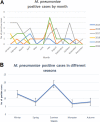Mycoplasma pneumoniae among Hospitalized Patients with Acute Respiratory Tract Infections in an Indian Tertiary Care Hospital: an Underreported Health Problem
- PMID: 35867428
- PMCID: PMC9430479
- DOI: 10.1128/spectrum.01589-22
Mycoplasma pneumoniae among Hospitalized Patients with Acute Respiratory Tract Infections in an Indian Tertiary Care Hospital: an Underreported Health Problem
Abstract
The epidemiology of Mycoplasma pneumoniae (Mp) is poorly understood in India. The present study was conducted to identify the prevalence of Mp in a large set of patients with acute respiratory tract infections (ARI) in an Indian tertiary hospital. During 2015-2020, we tested throat swab specimens from patients with the clinical diagnosis of ARI (n = 1,098) by a real-time PCR and compared the demographic, clinical, laboratory, and outcome data of Mp-positive and Mp-negative patients. During the study period, 5% (55/1,098) of the tested samples were positive for Mp by PCR. School-aged children and young adults represented 36% (20/55) of the cases and 47.3% (26/55) of the cases were registered during the summer and monsoon. Among the Mp-positive patients, 61.8% (34/55) had underlying conditions; the most common were malignancy (n = 12; 21.8%) and hypertension (n = 6; 10.9%). Fever (98.2% versus 84.9%; P = 0.006), and pharyngitis (27.3% versus 16.3%; P = 0.034) were significantly common in the Mp-positive group than Mp-negative group. Among the Mp-positive group, 20% (11/55) of patients were admitted to an intensive care unit and a total of 7/55 (12.7%) patients received ventilatory support. The mortality in the Mp-positive cohort was 13.3%. The study provides baseline data regarding Mp prevalence and clinical characteristics. The application of molecular assays for diagnosing this pathogen among hospitalized patients with ARI could reduce inappropriate empirical antibiotic treatment and improve patient outcomes. Further large-scale studies are required to avoid the underdiagnosis of Mp infections in India and such studies should address some research gaps, such as macrolide resistance and molecular typing. IMPORTANCE M. pneumoniae (Mp) is a significant pathogen causing atypical pneumonia but by far these infections are underreported clinical entities in India. In the present study, we report the prevalence of Mp and describe the demographic and baseline clinical data of Mp-positive cases in an Indian tertiary care hospital. Our study may improve the clinician's awareness of this important agent of respiratory infection therefore timely and accurate diagnostic tools can be applied for patient management decisions and outcomes.
Keywords: CARDS toxin; Mycoplasma pneumoniae; atypical pneumonia; molecular epidemiology; pneumonia; public health.
Conflict of interest statement
The authors declare no conflict of interest.
Figures

Similar articles
-
Prevalence of Mycoplasma pneumoniae-associated respiratory tract infections in hospitalized children: results of a 4-year prospective study in Tunis.Diagn Microbiol Infect Dis. 2010 Oct;68(2):103-9. doi: 10.1016/j.diagmicrobio.2010.05.010. Diagn Microbiol Infect Dis. 2010. PMID: 20846581
-
Clinical and Epidemiologic Features of Mycoplasma pneumoniae Infection Among Adults Hospitalized with Community-acquired Pneumonia.Int J Med Sci. 2024 Nov 11;21(15):3003-3009. doi: 10.7150/ijms.99233. eCollection 2024. Int J Med Sci. 2024. PMID: 39628678 Free PMC article.
-
Mycoplasma pneumoniae triggers pneumonia epidemic in autumn and winter in Beijing: a multicentre, population-based epidemiological study between 2015 and 2020.Emerg Microbes Infect. 2022 Dec;11(1):1508-1517. doi: 10.1080/22221751.2022.2078228. Emerg Microbes Infect. 2022. PMID: 35582916 Free PMC article.
-
[Macrolide-resistant Mycoplasma pneumoniae: Do we know the situation in Europe?].Rev Esp Quimioter. 2023 Jun;36(3):259-266. doi: 10.37201/req/118.2022. Epub 2023 Mar 27. Rev Esp Quimioter. 2023. PMID: 36966384 Free PMC article. Review. Spanish.
-
Overview of antimicrobial options for Mycoplasma pneumoniae pneumonia: focus on macrolide resistance.Clin Respir J. 2017 Jul;11(4):419-429. doi: 10.1111/crj.12379. Epub 2015 Oct 13. Clin Respir J. 2017. PMID: 26365811 Review.
Cited by
-
Childhood Mycoplasma pneumoniae: epidemiology and manifestation in Northeast and Inner Mongolia, China.Microbiol Spectr. 2024 May 2;12(5):e0009724. doi: 10.1128/spectrum.00097-24. Epub 2024 Apr 12. Microbiol Spectr. 2024. PMID: 38606996 Free PMC article.
-
Application of peripheral blood routine parameters in the diagnosis of influenza and Mycoplasma pneumoniae.Virol J. 2024 Jul 23;21(1):162. doi: 10.1186/s12985-024-02429-4. Virol J. 2024. PMID: 39044252 Free PMC article.
-
Post COVID-19 Pandemic Increased Detection of Mycoplasma Pneumoniae in Adults Admitted to the Intensive Care.J Clin Med. 2024 Jun 12;13(12):3443. doi: 10.3390/jcm13123443. J Clin Med. 2024. PMID: 38929972 Free PMC article.
-
Impact of COVID-19 on the Epidemiological Features of Mycoplasma pneumoniae Infection in Children with Community-Acquired Pneumonia in Henan, China.Microbiol Spectr. 2023 Feb 14;11(1):e0491122. doi: 10.1128/spectrum.04911-22. Epub 2023 Jan 23. Microbiol Spectr. 2023. PMID: 36688715 Free PMC article. No abstract available.
References
-
- Chen Z, Ji W, Wang Y, Yan Y, Zhu H, Shao X, Xu J. 2013. Epidemiology and associations with climatic conditions of Mycoplasma pneumoniae and Chlamydophila pneumoniae infections among Chinese children hospitalized with acute respiratory infections. Ital J Pediatr 39:1–8. doi:10.1186/1824-7288-39-34. - DOI - PMC - PubMed
MeSH terms
Substances
LinkOut - more resources
Full Text Sources

